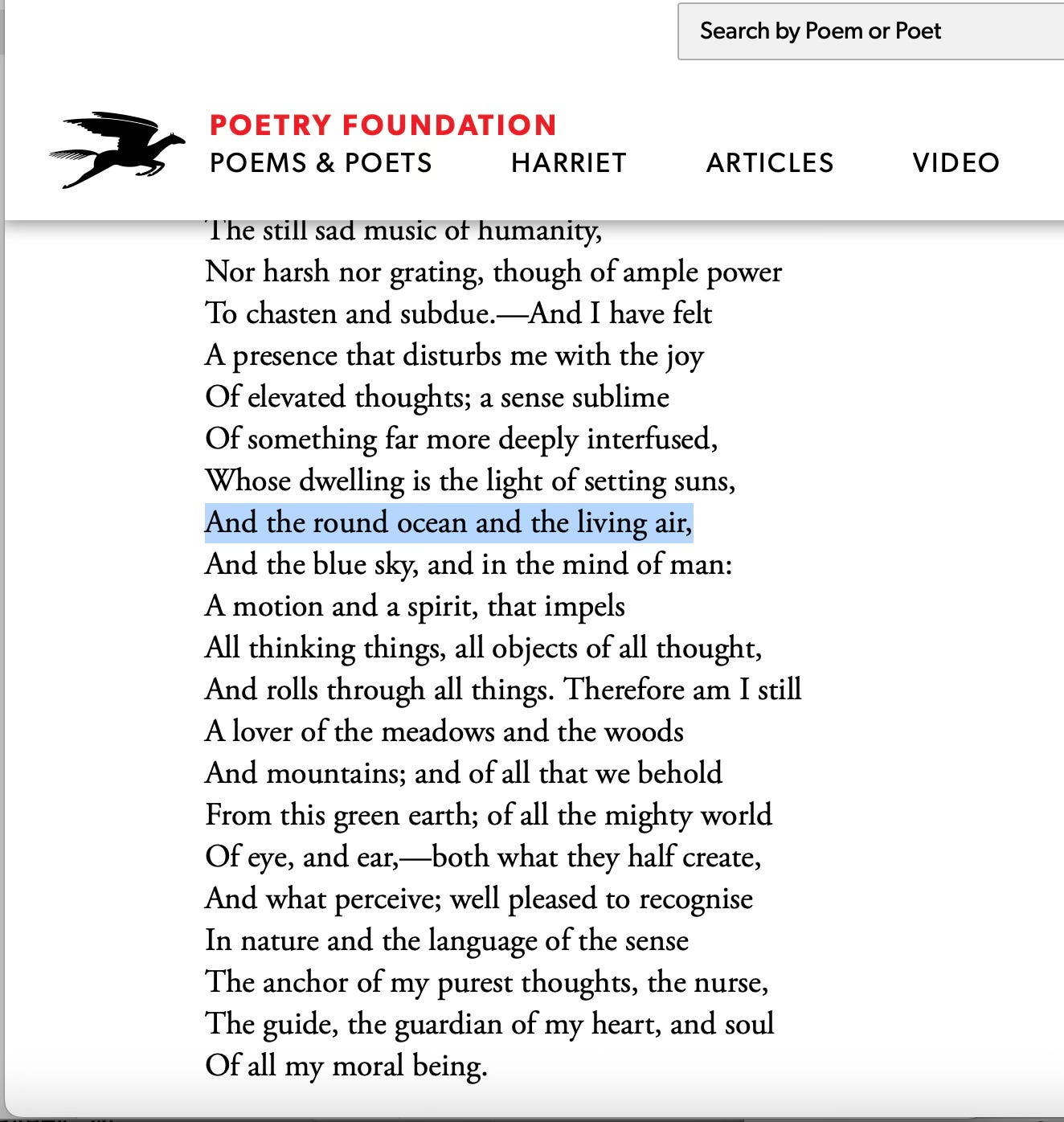Here I am again, not knowing where to start. I asked ChatGPT to recommend a poem and it recommended Lines Written Above Tintern Abbey: I found the round seas and living air of Wordsworth.
We love stories of the animated world.
Capture the superposition of science — of clarity — and mysticism — of wonder.
The soil is effervescent with life. Mushrooms are soil standing up. Trees are soil lofting into the living air. Rain is soil bonding with vapor and crystallizing, surfing, riding the rain home. Pseudomona Syringae (or something like this).
The horizon blooms in the distance, erupts briefly with a volcanic sunset, then the boundaries ember and dissolve. Settles into peaceful darkness, smell of diatoms on fish breath and breeziness and the soft / the sound of deep rolling tides. Sand calcifies to glass. (Not silicon, thought: that is from resources mined in Brazil at human effort and plant expense).
The tides bloom, the flowering tides.
Effervescent with dinoflagellates
The sea floor is an embodied archive of ancient life and minerals, and our limestone monuments made from it, carry the same lineage. One day will someone look back and wonder about the origin of plastic, of the humming undersea cables transmitting energy between the continents, of her own silicon-based ancestors, more fragile than carbon, perhaps encased in armor or another protective mechanism I can’t yet imagine.
We love stories of the animated world. Why do we treat it as poetry, feel ashamed of enchantment? As if we can co-evolve then step off the scale, isolate and weigh and measure, create recipes that don’t stir our own guts. A mass delusion.
Before the inquisitions and the witch hunts, the systematic burning of neighbors and women, the keepers of traditional knowledge and practitioners of earth-binding rituals. Even for those who have lost the thread, we can live in this world again.
Cracks
I’ve been keeping my eyes and ears open for cracks, and stories about cracks. Nature creates cracks in anything. But I just learned this:
Rivers began with cracks in the mud. When the earliest tiny land plants interrupted the direct run-off of water into the sea, this made it possible for soil to congeal into mud. Tiny animals, in turn, also adapted to this new consistently wet, fertile environment, wriggling through it instead of floating, blowing or digging. Think: the movement of an earthworm, wiggling through the mud, creating — cracks.
This in turn affected the water. Before, it had drained helter-skelter off to sea (think about how built-up water on the beach runs into the ocean — those little delta-like rivulets are called a braid)… Now the wriggling worms created grooves — cracks in the soil — and when it rained, water began to fill them, settle into them, move slowly through their bends and pebbly curves and eventually, thirsty root-filled banks. Those worm-cracks became rivers, and channeled the water as it moved over the land, so it eventually could be reliably found in places other than the beach. Life could form in and around these cracks, adapting new forms as the cracks deepened into rivers.
It would be 100 million years before giant rainforests would arise from this soil and crackwater, creating its own rain and calling it back to itself through nucleating microbes.
It would be 500 million years before we would begin to reverse this process, picking apart these adaptations, epoch by epoch, over the course of just a few generations.
Of all the scale-differences that arouse my awe — imagining the smallest bacteria to luminescing to imitate the largest galaxy — it’s maybe this one that dizzies me the most.
It hits me harder, of course, because it affects me personally.
4 billion years of enchantment, that the earth has been alive, embodied with life.
12:30 — time to script on Embodied Simulation (or new names: SUPERRADIANCE, Embodied Earth…)




